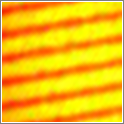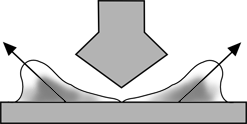Control of thermal emissivity

The thermal control in a spacecraft is a key issue in space engineering. Firstly, it should be considered that the electronic and mechanical devices shipped in a spacecraft work properly in narrow ranges of temperature. Secondly, it is also of relevance when designing a spacecraft to take into account the mechanical stress originated by the temperature gradients. On Earth the thermal control of a system can be controlled by means of the conduction, convection and radiation mechanism. However in space only the latter is available due to the characteristic high vacuum of this environment. Thus, it is of great interest to develop new materials or metamaterials capable of improve their thermal emissivity.
Recently it has been reported that the emissivity of a material can be enhanced by a factor 20 when a micro/nanostructure is processed on its surface [1][2].
Additionally the spatial distribution of the emissivity can also be controlled. Then, the material can emit radiation anisotropically instead of the usual isotropic emission of thermal sources (like the tungsten filament of a light bulb). This results reveals a new degree of freedom in the engineering of thermal radiators for a spacecraft. The emission direction of the released radiation can be designed in such a way that it could not be reabsorbed by any part of the spacecraft.
Main objectives of the project:
At the ACT we are mainly interested in aspects related with the design of devices able to provide some control over the coherence of the thermal emission. Coherent emission exhibits spectral peaks of thin broadness (temporal coherence) and/or angular lobes in well-defined directions (spatial coherence).

Coherent emission can be obtained using different technologies. The most common technique is to microstructure the surface of polar or metallic materials, e.g. grating engraving, exciting thus surface-phonon-polariton and surface-plasmon modes. In this project we restrict the discussion to radiators consisting of thin films arranged in multilayer stacks, with one or more of the layers able to sustain surface polaritons.
As mentioned before, we are mostly interested in design aspects of coherent thermal radiators. A very successful approach is to coat a 1D photonic crystal (PC) with a polar/metallic layer, or vice versa. In this way an effective evanescent wave existing inside of the PC in the stop band excites a surface polariton exhibiting the system an emission/absorption peak. The stop band of the PC is scaled accordingly to approximately match the polar material phonon absorption band [3], which in the case of SiC lies between 10.32 μm and 12.6 μm. Alternatively it is also possible to obtain a thermal emission source using an asymmetric Fabry-Pérot resonance cavity [4].
These rational design strategies have proven the possibility to obtain coherent thermal emission relying on planar multilayer structures. However, they do not show how to control the direction of the radiation lobes or the broadness of the emission. To achieve this goal a different approach should be taken. In particular, reversal engineering algorithms have been used for many years in the design of optical and infrared filters. The ACT together with the University of Nantes concluded that the genetic algorithm (GA) can provide a design of a thermal radiator with an expected temporal and spatial coherence [5].
As an extension of this seminal work, we have implemented the optimisation problem within ACT-DC, a distributed global optimisation environment developed internally at the ACT. With this tool we pursue to identify the limitations of the technology based on planar multilayer structures for developing coherent thermal radiator.
References
- J.-J. Greffet, R. Carminati, K. Joulain, J.-P. Mulet, S. Mainguy, and Y. Cheng, Coherent emission of light by thermal sources, Nature, 416, 61 (2002) [link]
- F. Marquier, K. Joulain, J.-P. Mulet, R. Carminati, and J.-J. Greffet, Coherent spontaneous emission of light by thermal sources, Physical Review B, 69, 155412 (2004) [link]
- B. J. Lee and Z. M. Zhang, Coherent thermal emission from modified periodic multilayer structures, Journal of Heat Transfer, 129, 17 (2007) [link]
- B. J. Lee and Z. M. Zhang, Design and fabrication of planar multilayer structures with coherent thermal emission characteristics, Journal of Applied Physics, 100, 063529 (2006) [link]